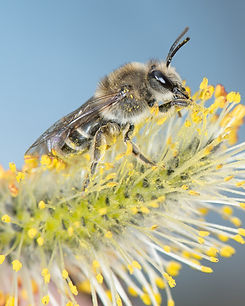
All About Bees > What is a Bee?
What is a Bee?
What makes a bee, a bee? Are they just hairy wasps or are there more differences than similarities between bees and wasps? Learn about some of the characteristics that make a bee, a bee, and what they have in common with wasps.




Bee Classification
Linnaean System of Classification
Bees are classified using the Linnaean system of classification. This system is hierarchical, ranging from broad (Kingdom) to specific (Species). Refer to the graphic below to learn more about the classification groupings or taxon. Included in the Linnean system of classification is binomial nomenclature, a system to describe each species with a Latin name consisting of two words—the genus and species. This two-word name is italicized; names in the higher level taxa are not italicized, for example the family or order.

Melissodes bimaculatus
Two-spotted long-horned bee
Each bee is described using a two-word or binomial classification consisting of the genus and species. For example, Melissodes bimaculatus (above) is a bee in the genus Melissodes and has a specific epithet (species name) bimaculatus.
Some bee species in Minnesota have a subspecies taxa assigned to the binomial name. Subspecies may occur when populations of a species are regionally disjunct, resulting in variations in coloration or other differences in morphological features that make them unique or distinct from other assigned subspecies. For example, the cellophane bee Colletes simulans, has four described subspecies. The subspecies armatus occurs in Minnesota—Colletes simulans armatus (spine-shouldered cellophane bee)—while the other three subspecies have distinct geographical areas such as the Southeast, Rocky Mountains, and West.

A graphic illustrating the classification for the two-spotted long-horned bee—Melissodes bimaculatus.
Hymenoptera
Order
Apocrita
Suborder
Aculeata
Infraorder
Apoidea
Superfamily
Clade
Anthophila
Evolution of Bees
Bees belong to the insect order Hymenoptera. This order also includes wasps, ants, sawflies, and horntails. Worldwide, there are approximately 150,000 species in the order Hymenoptera. The oldest and most primitive sawflies and wood wasps date back to the Triassic period, 250 million years ago (mya). The radiation or diversification of angiosperms (flowering plants) occurred during the Cretaceous period 145 mya, coinciding with the rise of bees, approximately 120 mya. This geologic period provided bees with an increase in the diversity and abundance of flowering plants, prompting the divergence of bees from their insect-hunting wasp ancestors in the superfamily Apoidea prior to the separation of Western Gondwana (South American and African continents), 100 mya. However, rapid and extensive diversification of bee species did not likely occur until bees broadened their specialized pollen host plant diet to one that was more diverse or polylectic.
Bees belong to the clade Anthophila within the superfamily Apoidea and infraorder Aculeata. In the early Paleogene (60-40 mya), bees migrated northward from South America into North America. Today, there are approximately 20,000 species of bees worldwide, more than 3,600 species in the United States, and approximately 800 species in Canada.
Bee Traits
In general, bees are hairier than wasps and have a combination of simple and plumose (feathery branched) hairs to which pollen grains effectively adhere. Like wasps, bees have two pairs of wings, and each pair (forewing and hind wing) is held together with tiny hook-like structures called hamuli.
There are additional similarities to Apoid wasps. For example, the majority of species have solitary belowground nests, and a minority nest aboveground in cavities in substrates or in freeform nests. However, in nature, organisms often don't fit into tidy categories. For example, in western North America there are pollen wasps (subfamily Masarinae) that collect and provision their nests with pollen. Also, in South America, there is a genus of bees (Trigona) that includes a few species that consume carrion instead of pollen!

Bees
Wasps
Explore Bee Families

Apidae
15 genera, 133 species
Bumble bees Bombus
Longhorn bees
Epimelissodes, Eucera, Melissodes
Carpenter bees
Ceratina, Xylocopa
Honey bees Apis
Digger bees Anthophora
Cuckoo bees Brachymelecta, Epeolus, Holcopasites, Nomada, Neolarra, Triepeolus
Squash bees Xenoglossa

2 genera, 39 species
Halictidae
10 genera, 133 species
Metallic green sweat bees
Agapostemon, Augochlora, Augochlorella, Augochloropsis
Large sweat bees
Dieunomia, Nomia
Short-faced bees Dufourea
Sweat bees Halictus
Small sweat bees Lasioglossum
Cuckoo (blood) bees Sphecodes
Megachilidae
14 genera, 86 species
Resin and pebble bees Anthidiellum, Dianthidium, Heriades, Paranthidium
Carder bees Anthidium, Pseudoanthidium
Mock orange bees Chelostoma
Mason bees Osmia, Hoplitis
Leafcutter bees Megachile
Sharp-tailed cuckoo bees Coelioxys
Dark cuckoo bees Stelis

Citations and Further Reading
Almeida, E. A., Bossert, S., Danforth, B. N., Porto, D. S., Freitas, F. V., Davis, C. C., ... & Pie, M. R. (2023). The evolutionary history of bees in time and space. Current biology, 33(16), 3409-3422.
Murray, E. A., Bossert, S., & Danforth, B. N. (2018). Pollinivory and the diversification dynamics of bees. Biology letters, 14(11), 20180530.
Page Photography Credits
Heather Holm












